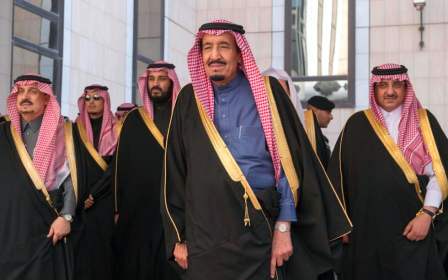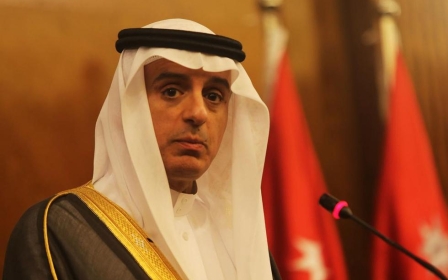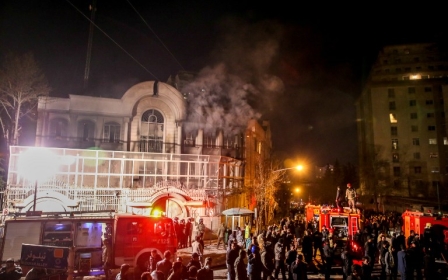Saudi-Iran crisis spells a long Syrian war

The Saudi decision to start the new year with mass executions bore the hallmarks of a calculated move. Riyadh doubtless anticipated that the Basij would do to Saudi diplomats what had been done to previous representatives of governments who had incurred the Ayatollah’s wrath. The Saudis were prepared to cut diplomatic relations, and ensure that other Arab states followed suit.
Not for the first time in recent months, an Iran which prided itself on anticipating the next step of its enemies and on outsmarting them, found itself wrong-footed by the Saudi move. Just as it was when Riyadh announced its military offensive against the Houthi takeover of Yemen, Iran still worked on old assumptions that Saudi Arabia moved cautiously and behind a bead curtain.
Here, however, the kingdom has played a different role. It has declared open season on the regional conflict with its Persian neighbour. This marks more than just one rung up the ladder of hostilities from its current stance of fighting proxies like the Iranian-backed Houthis, Syrian President Bashar al-Assad or Hezbollah.
Hostility is overt. It brings regional division to centre stage. Challenging the military and political influence that Iran has grown accustomed to wield in Syria, Yemen and Iraq since the US invasion in 2003 has now become official Saudi policy. Very little of the spectrum of bilateral relations are left intact, bar the offer to host Iranian Muslim pilgrims at the Hajj. Considering what happened at the Hajj last year, that too is now in doubt. All trade and air travel between the countries has now been cut.
For good or for ill, in sickness and in health, Saudi Arabia under King Salman has become an assertive regional force, prepared to back its interests with hard power. It has defined regional allies in Turkey and Qatar. It faces defined regional enemies in Iran and Russia. It is forcing other Arab states to choose sides. Bahrain and Sudan did so on Monday, while the Emirates downgraded their relations with Iran.
It would be interesting to learn how much notice Riyadh gave Washington of Foreign Minister Adel al-Jubeir's statement. Probably even less time than the decision to launch an attack on Yemen. Saudi Arabia no longer waits for the approval of its chief military patron and supplier. Like other US allies in the region, it is used to acting on its own.
The move spells the end, for now, to the Syrian ceasefire talks and possibly also Yemeni ones as well. The fallout from this weekend is unlikely to stop there. There is every indication that Riyadh will go on the offensive to restrict Iran’s re-entry to global markets, after its nuclear deal with Washington. Saudi Arabia will keep the price of oil at record lows, even at the cost of aggravating its own balance of payment crisis. It has already inflicted damage on the solvency of Russia's foreign trade bank Vnesheconombank, which needs $18bn to start lending again.
If this was planned, why was the plan carried out now? Forty-five of those executed were Saudi nationals, alongside a Chadian and an Egyptian. Forty-three were Sunnis, many of them al-Qaeda figures who had been on death row for periods stretching back to 2004. Their execution was a card Riyadh could have played anytime since the last wave of al-Qaeda bombings in 2012. Why was it played now, what political messages were sent and to whom?
Saudi Arabian rulers have faced two historic sources of internal dissent: the Shia minority, many of whom live in the Eastern Province, and Sunni jihadis. But only one of those sources makes the regime shake. Most analysts agree that Shia protests do not have the same ability. Of the 43 Sunni prisoners executed, the state media focused on Faris al-Shuwail al-Zahrani.
He was described as the ideologue behind a series of attacks on expats, police stations and oil plants which killed hundreds. In executing a “preacher of takfir”, the regime took on its ideological rival. In Wahhabi Salafism, only a state preacher can practise takfir, that is, declaring another person an infidel. This would have reassured the Sunni majority. But there was a message, too, for them. In a year in which the fuel subsidy is being lifted, overtime in state-run institutions is being cut, and everyone will have more taxes to pay, including a form of sales tax, the message is that no protest will be tolerated.
Externally, the execution of Shia cleric Nimr al-Nimr was certain to touch off protests abroad, as Iran had done so much to highlight his case. On cue, Hassan Nasrallah, the head of Hezbollah, and Moqtada al-Sadr, the Iraqi cleric, both reacted. According to the internal communique seen by The Independent, the head of Riyadh’s security services ordered police forces in the country to cancel any holidays scheduled for early 2016 and urged them to exercise “maximum precaution” until further notice.
The prospects of substantive Syrian talks had already been dealt a mortal blow by the alleged Russian air strike that killed Zahran Alloush, the leader of Jaish al-Islam. Alloush signed up for the Saudi peace process when other Syrian militia leaders walked away. In killing Alloush, Russia was showing, on Assad’s behalf, that it could fashion the negotiating environment by selecting which interlocutors lived. Alloush’s killing did less to the balance of forces on the ground outside Damascus than it did to Saudi determination to stop this.
Now the prospects of talks are dead. Instead, Saudi Arabia is cultivating a deepening security relationship with Turkey. Billions of dollars of contracts for advanced Turkish weaponry are rumoured to be in the offing as a result of the Turkish President Recep Tayyip Erdogan’s latest visit to Riyadh.
The intensity and lethality of the combat in Syria that escalated when Russian warplanes began bombing largely opposition targets from the air are now set to escalate from the ground as well. As the front lines have changed little, this only means the conflict will be prolonged. Any talk of civil war winding down in local ceasefires now looks like the optimistic prattle of the past.
For at least one of the intervening powers, Russia and Iran on one side and Turkey, Saudi Arabia and Qatar on the other, Syria will become an Afghanistan - a war from which one foreign power will have to beat an ignominious retreat. Saudi Arabia, whose foreign policy is popular among the majority-Sunni population of the region, is confident it will not be the one doing that.
This can only entrench conflict in the region in 2016. If 2015 was violent, this year is set to become even more so. The Saudi move will be as much a challenge for Egypt. Until now, the Saudi paymasters of the Egyptian military ruler Abdel Fattah al-Sisi tolerated the cold response Egypt gave to Saudi Arabia in Yemen and Syria. How much longer that will be the case with the Egyptian rapprochement to Russia and Iran remains to be seen.
Whichever way you cut it, this is not a move from which any side can back down quickly. There are high stakes internationally, and each player in this conflict feels it has already invested too much to shove the machine into reverse gear. Each government feels vulnerable internally. There is little leeway for compromise. Ultimately, a balance of power has to be drawn between Iran and Saudi Arabia. That will now be achieved in an international test of wills played out in a region bristling with weapons and wielded exclusively by people who know how to use them.
- David Hearst is editor-in-chief of Middle East Eye. He was chief foreign leader writer of The Guardian, former Associate Foreign Editor, European Editor, Moscow Bureau Chief, European Correspondent, and Ireland Correspondent. He joined The Guardian from The Scotsman, where he was education correspondent.
The views expressed in this article belong to the author and do not necessarily reflect the editorial policy of Middle East Eye.
Photo: Iranian security forces at the Saudi embassy in Tehran after it was burned by demonstrators protesting against the execution of Saudi Shia cleric Nimr al-Nimr
Middle East Eye propose une couverture et une analyse indépendantes et incomparables du Moyen-Orient, de l’Afrique du Nord et d’autres régions du monde. Pour en savoir plus sur la reprise de ce contenu et les frais qui s’appliquent, veuillez remplir ce formulaire [en anglais]. Pour en savoir plus sur MEE, cliquez ici [en anglais].





